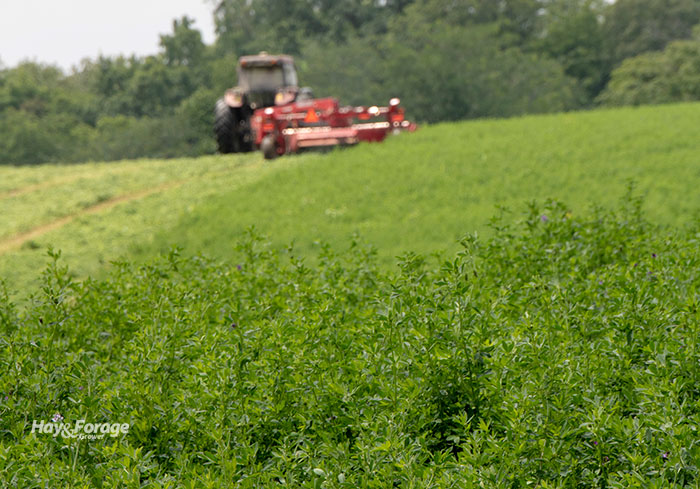
When our little Jack Russell Terrier needs an outdoor potty break, he jumps up on a bench in our living room and rattles the window blinds with his nose. It’s his way of telling my wife and I that the door better be flung open soon or there will be consequences.
I might also mention that he’s learned to exhibit this same quirk when spotting an errant rabbit or squirrel entering his backyard domain. In this case, the consequences are directed toward the wildlife after the door is opened.
There are many examples of things that show us when action is soon needed. This is also true for crops. For example, the movement of the kernel milkline in corn is a good guide that indicates when we should start monitoring whole-plant moisture for silage harvest.
Unfortunately, alfalfa is not a great communicator. Its forage quality can change ever so quickly, or it may change at what seems like a snail’s pace. Both extremes are amplified for the initial growth of alfalfa during spring, and plants can look nearly identical at both ends of the forage quality spectrum.
The initial spring cutting of alfalfa can make or break a harvest season. For this reason, every means possible must be taken to know when alfalfa is ready to cut based on the class of livestock being fed. We have to do the window blind rattling.
Temperature and moisture matter
No other cutting of alfalfa grows under the environmental conditions offered by spring. During early plant development, temperatures are mostly cool, which is good news from a forage quality standpoint. As vegetative growth continues and into early reproductive (bud) stages, the potential weather scenarios span any number of possible outcomes.
This range of environmental conditions makes it nearly impossible to eyeball forage quality. Calendar dates are useless, as is phenotypic maturity stage. Relative forage quality (RFQ) can be as much as 100 points different from year-to-year on the same date, and the same can be said for forage quality at a given stage of maturity.
To be sure, Mother Nature is calling the shots on forage quality when it comes to first cutting. Unfortunately, she doesn’t rattle the window blinds either.
Hot and wet weather brings much different results than cool and dry. Further, environmental conditions change from day-to-day more in the spring than at any other point in the growing season. Therefore, it’s important to pay attention and monitor forage quality more so than any other cutting of the season.
Alfalfa practitioners and researchers have spent years developing systems to estimate forage quality without physically cutting plants and sending them to a forage laboratory for analysis, although the latter approach works, too.
By now, most growers are familiar with the predictive equations for alfalfa quality (PEAQ), which is based on plant height and maturity stage. Another popular approach is based on tracking growing degree units (GDU). Both methods will be far more effective than looking at plants or the calendar. Choose your weapon but choose a weapon.
Best or worst
First-cut fiber digestibility can be the best of the season; those mostly cool days and nights are generally the hay producer’s friend. Once warm to hot weather sets in, or if wet weather delays the harvest, fiber digestibility can quickly move from the best to the worst of the year. This is true for monoculture alfalfa stands and even truer for alfalfa-grass stands.
The rate of fiber digestibility decline is unmatched by any other alfalfa cutting. This means that the harvest window is usually smaller, unless extended cool weather prevails. Here’s where new alfalfa genetics that can lower lignin content and, in turn, raise neutral detergent fiber digestibility (NDFD) by as much as 15%, which will help widen this window.
Rapid yield accumulation
While capitalizing on forage quality is important from a livestock performance standpoint, no cutting of alfalfa offers the opportunity for high yields more than the first. In fact, it usually comprises the highest percentage of total-season yield compared to subsequent harvests.
This enhanced yield potential means that whatever forage quality is obtained — good or bad — your barn or silo is going to be full of it, and you’ll live with spoils or consequences for most of the ensuing year.
Just as forage quality changes both between years and within a given year, so does alfalfa yield change more dramatically than any other cutting. Estimates are that alfalfa packs on 100 to 150 pounds of dry matter per acre per day during the late-vegetative to late-bud stages. In five days, dry matter yield jumps 1/4 to over 1/3 ton per acre. The yield x quality tradeoff is never so in play as it is with first cutting.
First cutting is the only one when there is no number of days since the previous harvest. The first-cut harvest decision often dictates the schedule for the rest of the season. When the first cut is made may impact how many future cuttings will be possible, the interval between cuttings, and how late in the fall the final cutting will be harvested, which, in turn, impacts future stand life.
Although the weather can’t be controlled, we can at least make informed decisions of when it’s time to cut alfalfa. If someone doesn’t rattle the window blinds to get the mower greased, there will be long-term consequences.

